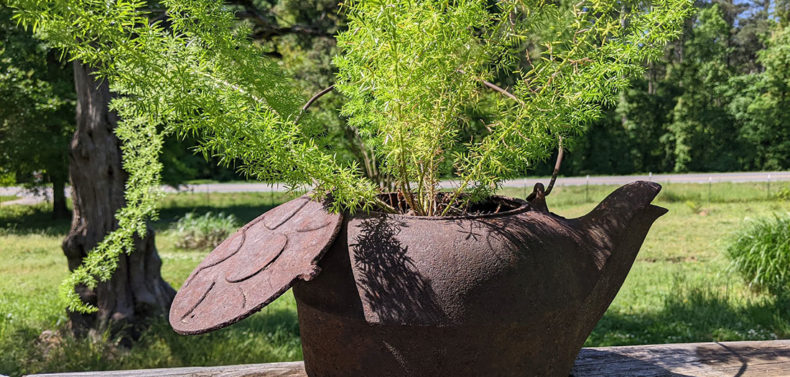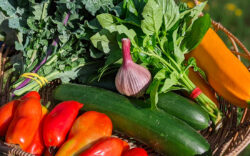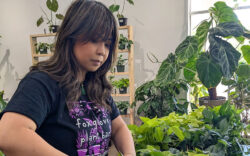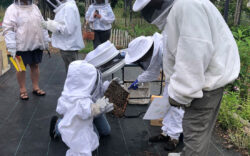I promise, you can grow outside, even if you don’t have a yard! It’s all about choosing the tools that fit your space and adjusting where necessary. Not every garden needs to be a perfectly constructed permanent raised bed. Here are a few ideas that worked for me—and a few that failed miserably—for starting your porch or balcony garden.
Do use your vertical space with railing planters and hanging baskets. Three baskets and two rail planters can really change the feel of a balcony and provide enough space for growing herbs, a few lettuces and a pepper plant. If you’ve got a lot of shade and you want to grow into your green thumb, opt for ferns in hanging baskets.
Don’t buy the hanging baskets or railing planters with a coconut coir liner. Those planters look great, but they dry out very quickly. I’d only suggest this if you have a tendency to drown your plants. It’s nearly impossible to overwater anything in this planter.
Do provide at least 8 inches of soil depth for heavy feeding plants like tomatoes, eggplants, peppers and roses. You might be able to get away with less soil, but it could affect the amount your plant is able to produce.
Don’t overcrowd your smaller pots with heavy feeders of the same type. Try to keep it to one tomato plant or one pepper plant at a time. These plants can compete with each other for sunlight, water and soil nutrients, leaving you with smaller, less productive plants. If your container is 18 inches or wider, you can sneak two heavy feeders in the same planter.
Do plant different types of plants together. Pair your tomato plant with two basil seedlings. Stick cilantro and parsley next to pepper plants. Companion planting looks great (So full! So abundant!) and usually doesn’t result in the same competition for sunlight, space and nutrients. To start experimenting with companion planting, try thyme or sweet alyssum with any other plant. Choose three to seven plugs and plant around the anchor plant. With luck and care, you’ll have a productive heavy feeder and a luscious mat of green falling over the lip of the planter in a few weeks.
Don’t use the 5-gallon buckets if you’ve got 8-plus hours of sunlight on your porch. I know. Five-gallon bucket gardens are a regular recommendation from the Internet. Five-gallon buckets are cheap and easy to find. They’re also not cut out to handle sunlight and will crack, chip and disintegrate after a year of use. The only ones I’ve had luck with are discarded food-grade buckets. Big-box-store buckets work for some projects, but not sunny gardening ones.
Do experiment with thrifted and yard sale finds as planters. I love my old, rusted tea kettle pot with the bright green fox fern growing out of it. The kettle sports a bunch of drainage holes from rust damage. All I had to do was pick a plant that could handle a drier habitat. I’ve thrifted cups, saucers and bowls to turn them into planters. I admit, it’s an eclectic style that ventures into tacky for some.
Don’t choose containers made of rubber, such as old gardening boots, or cinder blocks. These planters bake almost all roots in the Georgia July sun. Maybe cinderblock and rubber boot planters work in more Northern climes—not here.
Do fertilize when you start seeing blooms. Container gardens don’t have access to the same nutrients that in-ground gardens do, so it’s important to keep them fed. I give extra compost to all my ornamental container plants in the spring. I follow it up with fertilizer for the hungriest friends, such as my Meyer lemon tree, rose bushes and peppers in April and June. I use organic fish fertilizer (Neptune’s Harvest is my favorite). It smells. Dogs will want to eat it. But it’s hard to over-fertilize and cause root burn. Don’t fertilize if you bought a potting mix that has a slow-release formula. Or if everything looks healthy. Or if you haven’t watered first. Sometimes, new gardeners think of fertilizer like a silver bullet that will fix and prevent any growing problems. Too much fertilizer can be a problem. And some issues can’t be fixed with fertilizer. Use it judiciously when needed.
Like what you just read? Support Flagpole by making a donation today. Every dollar you give helps fund our ongoing mission to provide Athens with quality, independent journalism.










